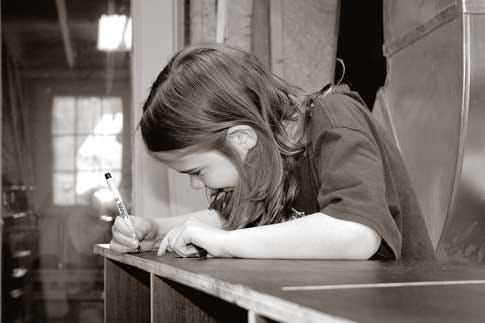Publisher’s note: Welcome to Earlywood, a free weekly excerpt from one of the thousands of pieces I’ve written since 1996. Sometimes, it’s from a magazine article. Or a book. Or (in this case) a blog post published in 2008. Each entry has been updated or annotated with some modern context or point of view. Enjoy!
Now that shop class is as common in high schools as poodle skirts, lots of woodworkers worry about passing on our enthusiasm for the craft to the next generation. So, when my kids were younger, I started treating them more like apprentices.
They helped clean the shop. They assisted me on projects at assembly time. They worked on their own projects on the side when I didn’t need them. And – here’s the odd part – I paid them (a pittance) for their help and swore them to secrecy on the “arts and mysteries” of the craft.
One weekend, I assembled a large run of shelving that I planned to install in the recipient’s home that week. There was a lot of tedious gluing, clamping and clean-up work involved, so I hired 7-year-old Katy to help.
First, I showed her the “secret” to achieving a perfectly smooth lacquer finish – a folded-up brown paper bag. We rubbed all the surfaces vigorously, which knocked down any surface imperfections without cutting through the film finish. Katy did the shelves; I did the uprights.
“Cool,” she said. “It works!”
As we were bagging the lacquer, both of us noticed that there were some small dings and scratches in the color. This is was the result of the parts getting moved around more than I like. So I swore Katy to secrecy again and introduced her to the mystery of stain pens. In this case, the best match wasn’t one of my stain pens (which I keep hidden away), it was a black Sharpie marker.
In fact, Katy became incredulous when I took her picture at work with the marker.
“What if someone sees the picture and figures out our secret?” she asked. “Then they’ll know!”
Then we glued up the shelves. I applied the glue. Katy added the Dominos. We both applied the clamps and cleaned the glue squeeze-out. Assembly can be stressful for me, but Katy’s amazement at how the project came together kept my anxiety in check.
We did four major glue-ups this weekend, and by the fourth one, Katy dove into the work like she had been doing it all her life. I wonder if learning woodworking is like learning a foreign language – it might be easier when you are young.
As I added the kicks to the cabinet, Katy worked at the bench at her own project – she’s transforming my discarded shop jigs for this shelving project into a wooden alligator.
Then I paid her (about $1 an hour for the shop time) and I asked her if she’d come along on the installation next week. Without hesitation, she said: “Yes! Hurray!”
And she did.
And it’s 2025
Katherine is about to sign apprenticeship papers with me to become a chairmaker. She’s been working full-time with me for the last three months, and I wish I could tell you it’s different than when she was 7. It’s not. It’s just as awesome.
Katherine is as enthusiastic as she was when she worked with me in the shop as a kid. I sometimes have to pinch myself and ask: Is this real?
It is.
Lucy and I refused to pressure either of our children to become woodworkers or writers or anything else other than this: happy. We tried to expose them to what we did, and we explained the good and the bad of it.
We didn’t have to explain it much. They lived though the lean times when paying for a guinea pig’s emergency care was almost more than we could afford. They saw me sell chairs for $600 that took me a month to make. And they helped count our change jar at the end of the year, which helped pay for Christmas presents.
But they also saw me sell a chair for $5,000. And their mother become the host of the city’s most important radio program, “Cincinnati Edition.”
And they made their choice.




My dad was a small volume general contractor. I started working for him at age 7. He paid me 50 cents an hour (1/3 the minimum wage in 1970). My first job was gathering up the nails the carpenters dropped and sorting them back into their proper boxes. My first tool was a push broom. Then I graduated to a hammer (I still use it… great old Plumb) - driving the nails through the plywood decking after the carpenters positioned it. Then framing. Then finish carpentry. Years later, I came home from graduate school one summer and my father handed me a set of plans, permits, and a list of his subs. He told me to have Mom’s addition done by the time I went back to school. I guess that was my Master Work.
When I graduated, he asked me if I wanted to join him in the building business. While I declined, I have never stopped using the arts and secrets I learned in those decades. And, I’ve taught them to my kids too.
My dad and get along great… as long as we are not together for more than about 2-3 days. Working together (farming) even though I would have loved to would not have worked. Grandpa and I different story. Appreciate what you have.